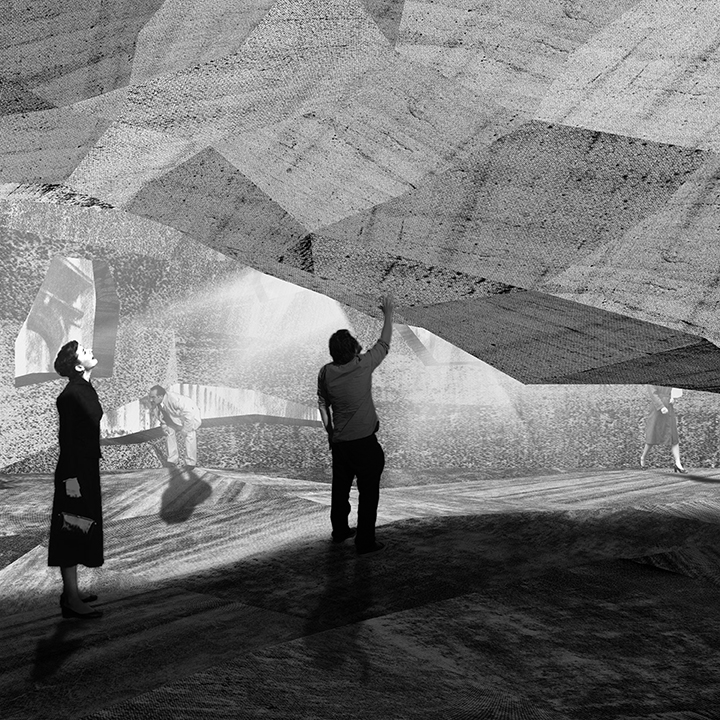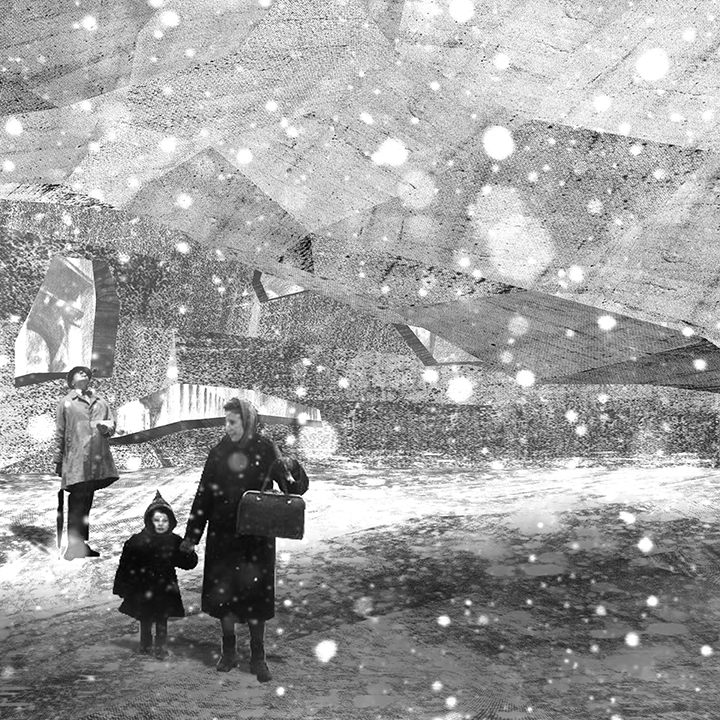INSTITUTE FOR IMAGINING NY FARM PRIZE

Miles Fujiki interview by Alessandro Orsini (NY CityVision Juror)
AO: La tua proposta mi ricorda l’Atlante Mnemosyne di Aby Warburg. Un’idea di progettazione correlata all’idea di architettura come rovina? Come testimone del tempo?
W: Quando ho iniziato a lavorare a questo progetto, ero ossessionato dallo stato di rovina dell’architettura o della città. In entrambi era forte il senso di degrado fisico, o rugosità, generato dal passare del tempo, e lo spazio che, attaverso il rapporto tra l’abitazione, le persone e l’architettura, si discostava completamente dal suo intento. Per me entrambe le condizioni portano ad una nostalgia pericolosamente romantica o feticizzazione delle rovine; è un’opportunità radicale per sognare e immaginare quello che potrebbe essere o che sarebbe stato. Allo stesso tempo sarebbe più facile partire da una situazione di tabula rasa, vista l’attuale condizione di uno spazio esistente con la propria storia reale e immaginaria. Volevo catturare la qualità di queste rovine che esigono re–immaginazione e resistono al ready–made della rovina a favore di spazi e di una materialità che resiste al tempo, piuttosto che cadere vittima del mandato popolare dell’architettura contemporanea, che deve essere costantemente curata per rimanere in uno stato d’essere costantemente”nuovo”.
AO: Il Museo d’Arte Moderna di New York, inaugura la mostra “9 + 1 Ways of Being Political”: 50 anni di posizioni politiche in Architettura e Urban Design” a cura di Pedro Gadanho. Leggendo il tuo testo dichiari che “Nella città incerta, l’economia bruta detta la forma fisica e l’esperienza.” È l’idea alla base della mostra, ovvero di una situazione economica che sta travolgendo il potenziale politico dell’architettura, che era la base fondamentale delle avanguardie del XX secolo. Hai pensato a questo durante la fase preliminare del progetto?
W: La mia idea di città contemporanea, in particolare di New York, è che le cose che non sono redditizie, sia che siano espresse in dollari che in capitale politico o culturale, non sono capitali vitali, e quindi sono una perdita di tempo. È questo per me l’economia bruta. Io credo che ci siano cose al di fuori di questo dato che potrebbero portare a un nuovo valore fondamentale per la città. Anche se si tratta di una situazione contemporanea in cui l’economia è detta bruta, o ha sempre dominato in una certa misura, penso che in questo momento i cittadini di una città siano i responsabili della concezione fisica dell’ambiente politico. Per architetti e pianificatori, immaginare diventa sempre più miopia. Parte di questo concetto è il caposaldo indiscusso del diritto del mercato. Sì, il crollo economico ha indotto molti a scatenarsi e fare un sacco di rumore, ma un’alternativa credibile, o anche parallela, non è stata ancora trovata per New York. In architettura, credo che questo sia il dominio completo della narrazione ambientale così come un’ossessione continua con gli effetti di calcolo. Questi effetti comprendono le sue promesse di razionalizzazione, l’ottimizzazione e l’efficienza, che sono tutti condizioni di mercato. Non nego l’importanza o la realtà di questi problemi per le nostre città e la disciplina, ma contesto la mancanza di alternative e il valore che possiedono al di fuori di una definizione stretta e molto conservatrice.
AO: I tuoi disegni in bianco e nero mescolati alla fotografia sono molto poetici rispetto alle immagini super–appariscenti che vediamo pubblicate costantemente di nuovi progetti, più reali e meno poetici. Cosa pensi della rappresentazione delle idee in architettura e delle sue implicazioni?
W: Questo progetto è il mio tentativo di provocare re–imaginazione degli architetti e dei cittadini urbani, fornendo uno spazio e una piattaforma per i reimmaginare che questo si verifichi. Il progetto è stato guidato da idee di base che hanno impregnato l’architettura, la narrazione e la rappresentazione. Io personalmente non sono interessato a ultra rendering realistici o ad una grafica appariscente, ma piuttosto alle tecniche che comunicano ed esplorano le idee che stanno dietro ad un progetto in un modo più profondo, più operativo. L’estetica predominante della rappresentazione, in molti casi, ha poco a che fare con l’impatto “reale” o l’esperienza dell’architettura, e comunica invece solo un fredda immagine. Credo anche nel processo di “costruzione” dei disegni piuttosto che nell’impostazione dei parametri lasciando che il computer faccia il disegno per noi. Così ho comunicato subito graficamente le mie idee e le intenzioni del progetto, e la sperimentazione dei suoi effetti architettonici, urbani, ed intimi. Queste non sono immagini finite ma disegni funzionali (o in azione). Vorrei continuare a esplorare la rappresentazione e le sue implicazioni, nonché sondare il progetto nell’immaginazione alternativa all’interno della città.
Caro Alessandro,
Grazie per questa opportunità nel mostrare il mio lavoro. Sono onorato di essere stato selezionato per questa pubblicazione.
Saluti, Miles Fujik
ENGLISH VERSION_________________________________________________________________

AO: our proposal reminds me the Mnemosyne Atlas by Aby Warburg. Is you design related to the idea of architecture as a ruin? As witness of the time?
W: When I began working on this project, I was obsessed with a ruinous state of architecture or cities. Both in its physical state of decay or roughness achieved by the passage of time, and as space where the inhabitation and relationship between people and architecture has totally diverged from its intent. For me both of these conditions allow a dangerously romantic nostalgia or fetishization of ruins, and a radical opportunity to dream and imagine what could be or what could have been. At the same time, it is more powerful than starting with a tabula rasa situation, because you are working with an existing condition and an existing space with its own real and imagined history. I wanted to capture this quality of ruins that demands reimagination and to resist the ready–made ruin in favor of spaces and a materiality that would weather and age— rather than fall victim to the popular mandate of contemporary architecture, which is to be constantly groomed in order remain in a state of being that is constantly “new.”
AO: The Museum of Modern Art in New York just opened an exhibition called “9 + 1 Ways of Being Political: 50 Years of Political Stances in Architecture and Urban Design” curated by Pedro Gadanho. Reading your text you state “In the uncertain city, brute economics dictates physical form and experience”. It’s the idea behind the exhibition that the economical situation is overwhelming the political potential of architecture which was the fundament of the avant– garde movements of the 20th century. Did you think about this during the preliminary stage of your project?
W: My understanding of the contemporary city, specifically New York, is that things that are not profitable—whether that’s measured in dollars, political capital, or cultural capital—are not viable, and therefore are a waste of time to think about. That for me is brute economics. I believe that there are things outside of this metric that could bring new and fundamental value to the city. While it is up for debate whether it is a contemporary situation that brute economics dictates, or has always dominated to some degree, I do think that now, for citizens of cities and those responsible for shaping the physical environment—politicians, developers, architects, planners—for them, imagination is becoming increasingly myopic. Part of that is the still–undisputed right of the market. Yes, the economic crash caused many to lash out and make a lot of noise, but a credible alternative or even parallel has not been established in New York. In Architecture, I believe it is the complete domination of the environmental narrative as well as a continuing obsession with computation’s effects. These effects include its promises of rationalization, optimization, and efficiency, all of which are market terms. I do not deny the importance or reality of these issues for our cities and discipline, but I do dispute the lack of alternatives and the value they possess outside of a narrow and very conservative definition.
AO: Your black and white drawings mixed with photography are very poetic compared to the super flashy images we see published all the time about new projects, more real and less poetic. What do you think about the representation of ideas in architecture and its implication?
W: This project is my attempt to provoke reimaginations by Architects as well as urban citizens by providing a space and a platform for those reimaginations to occur. It was driven by core ideas that permeated into the architecture, narrative, and representation. I personally am not interested in ultra realistic renderings or flashy graphics, but rather in techniques that communicate and explore ideas behind a project in deeper, more operative ways. The predominant aesthetic of representation, in many cases, has little to do with the “real” impact or experience of the architecture, and instead communicates only an imagistic cool. I also believe in the process of “building” drawings rather than setting parameters and letting the computer make the drawing for you. So I was at once graphically communicating my ideas and intentions of the project, and testing its urban, architectural, and intimate effects. These are not finished images, they are working drawings. I would like to continue to explore representation and its implications as well as the project of probing alternative imaginations within the city.
Dear Alessandro,
Thank you for giving me this opportunity to show my work. I am honored to be selected to be apart of this publication.
Best wishes, Miles Fujiki.
Related Posts :
Category: Article
Views: 2719 Likes: 0
Tags: city vision , city vision competition , Miles Fujiki , Museum of Modern Art
Comments:
Info:
Info:
Title: INSTITUTE FOR IMAGINING NY FARM PRIZE
Time: 30 ottobre 2012
Category: Article
Views: 2719 Likes: 0
Tags: city vision , city vision competition , Miles Fujiki , Museum of Modern Art







